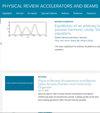用复活的BNL交替梯度同步加速器电子模拟环规划电偶极矩
Physical Review Special Topics-accelerators and Beams
Pub Date : 2015-07-22
DOI:10.1103/PHYSREVSTAB.18.074004
引用次数: 3
摘要
近年来,人们对直接测量质子和电子的电偶极矩(EDM)产生了浓厚的兴趣。这样的测量需要在全电存储环中存储一束“冻结自旋”粒子的极化束。迄今为止,只有一个这样的相对论性电子加速器被建造出来——1954年在布鲁克海文国家实验室建造的“电子模拟”环。碰巧的是,这个早已被拆除的电子环既适合于测量电子EDM,也可以作为一个廉价的原型,用于更有前途的,但要贵十倍的质子EDM测量。如今,通过计算模拟电子模拟环的性能来“复活”电子模拟环要便宜得多。这是本文的目的之一。为了建立这些计算,需要一种“考古物理学”来重建详细的电子模拟晶格设计。新的UAL/ETEAPOT代码,在随附的论文中详细描述,已经开发用于模拟存储环性能,包括(精确的BMT)自旋演化,在电环中。说明它的使用,将它的预测与旧的观察结果进行比较,并描述关于自旋演化和代码性能的新期望,是本文的其他目标。本文描述了ETEAPOT代码的实际应用,并提供了示例结果,重点是在AGS模拟环中模拟晶格光学,以便与历史上的加工研究进行比较,并预测他们将测量到的电子自旋演化。为了展示ETEAPOT代码的性能并确认其辛性,还给出了在全电晶格中3000万转质子自旋跟踪的结果,这将适用于目前的质子EDM测量。本文章由计算机程序翻译,如有差异,请以英文原文为准。
Electric dipole moment planning with a resurrected BNL Alternating Gradient Synchrotron electron analog ring
There has been much recent interest in directly measuring the electric dipole moments (EDM) of the proton and the electron. Such a measurement will require storing a polarized beam of "frozen spin" particles in an all-electric storage ring. Only one such relativistic electric accelerator has ever been built---the "Electron Analogue" ring at Brookhaven National Laboratory in 1954. By chance this electron ring, long since dismantled, would have been appropriate both for measuring the electron EDM and to serve as an inexpensive prototype for the arguably more promising, but ten times more expensive, proton EDM measurement.
Today it is cheaper yet to "resurrect" the Electron Analogue ring by simulating its performance computationally. This is one purpose for the present paper. To set up these calculations has required a kind of "archeological physics" to reconstitute the detailed Electron Analogue lattice design. The new UAL/ETEAPOT code, described in detail in an accompanying paper, has been developed for modeling storage ring performance, including (exact BMT) spin evolution, in electric rings. Illustrating its use, comparing its predictions with the old observations, and describing new expectations concerning spin evolution and code performance, are other goals of the paper.
This paper describes the practical application of the ETEAPOT code and provides sample results, with emphasis on emulating lattice optics in the AGS Analogue ring for comparison with the historical maching studies and to predict the electron spin evolution they would have measured. To exhibit the ETEAPOT code performance and confirm its symplecticity, results are also given for 30 million turn proton spin tracking in an all-electric lattice that would be appropriate for a present day measurement of the proton EDM.
求助全文
通过发布文献求助,成功后即可免费获取论文全文。
去求助
来源期刊
自引率
0.00%
发文量
0
审稿时长
3-8 weeks
期刊介绍:
Physical Review Special Topics - Accelerators and Beams (PRST-AB), is a peer reviewed, purely electronic journal, distributed without charge to readers and funded by contributions from national laboratories. It covers the full range of accelerator science and technology: subsystem and component technologies, beam dynamics; accelerator applications; and design, operation, and improvement of accelerators used in science and industry. This includes accelerators for high-energy and nuclear physics, synchrotron radiation production, spallation neutron sources, medical therapy, and intense beam applications.

 求助内容:
求助内容: 应助结果提醒方式:
应助结果提醒方式:


